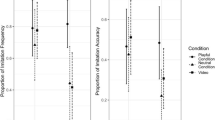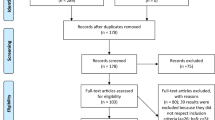Abstract
We investigated whether typically-developing children with a gift for drawing realistically show the local processing bias seen in individuals with autism spectrum disorder (ASD). Twenty-seven 6–12 year-olds made an observational drawing (scored for level of realism) and completed three local processing tasks, and parents completed the Childhood Asperger Syndrome Test (CAST). Drawing score predicted local processing performance on all tasks independently of verbal IQ, age, and years of art lessons. Drawing score also predicted more frequent repetitive behaviors as assessed by the CAST. Thus, skill in realistic drawing is associated with a strong local processing bias and a tendency towards repetitive behaviors, showing that traits found in individuals with ASD irrespective of artistic talent are also found in typically developing children with artistic talent.




Similar content being viewed by others
References
American Psychiatric Association. (1994). Diagnostic and Statistical Manual of Mental Disorders (4th ed.). Washington, DC: American Psychiatric Association.
Bölte, S., & Poustka, F. (2006). The broader cognitive phenotype of autism in parents: How specific is the tendency for local processing and executive dysfunction? Journal of Child Psychology and Psychiatry, 47, 639–645.
Brown, W. A., Cammuso, K., Sachs, H., Winklosky, B., Mullane, J., Bernier, R., et al. (2003). Autism-related language, personality, and cognition in people with absolute pitch: Results of a preliminary study. Journal of Autism and Developmental Disorders, 33, 163–167.
Caron, M. J., Mottron, L., Berthiaume, C., & Dawson, M. (2006). Cognitive mechanisms, specificity and neural underpinnings of visuospatial peaks in autism. Brain: A Journal of Neurology, 129, 1789–1802.
Constantino, J. N., & Todd, R. D. (2003). Autistic traits in the general population: A twin study. Archives of General Psychiatry, 60, 524–530.
Edgin, J. O., & Pennington, B. F. (2005). Spatial cognition in autism spectrum disorders: Superior impaired or just intact? Journal of Autism and Developmental Disorders, 35, 729–745.
Edwards, B. (1989). Drawing on the right side of the brain. Tarcher.
Golomb, C. (1992). The child’s creation of a pictorial world. Berkeley, CA: University of California Press.
Grinter, E. J., Ban Beek, P. L., Maybery, M. T., & Badcock, D. R. (2009). Brief report: Visuospatial analysis and self-rated autistic-like traits. Journal of Autism and Developmental Disorders, 39, 670–677.
Happé, F., & Ronald, A. (2008). The ‘fractionable autism triad’: A review of evidence from behavioural, genetic, cognitive and neural research. Neuropsychological Review, 18, 287–304.
Jolliffe, T., & Baron Cohen, S. (1997). Are people with autism and Asperger syndrome faster than normal on the Embedded Figures Test? Journal of Child Psychology and Psychiatry and Allied Disciplines, 38, 527–534.
Kaufman, A. S., & Kaufman, N. L. (2004). Kaufman brief intelligence test (2nd ed.). Circle Pines, MN: American Guidance Service.
Kuschner, E. S., Bodner, K. E., & Minshew, N. J. (2009). Local vs. global approaches to reproducing the Rey Osterrieth Complex Figure by children, adolescents, and adults with high-functioning autism. Journal of Autism and Developmental Disorders (in press).
Mandy, W. P., & Skuse, D. H. (2008). Research review: What is the association between the social-communication element of autism and repetitive interests, behaviours and activities? Journal of Child Psychology and Psychiatry, 49, 795–808.
Milbrath, C. (1998). Patterns of artistic development in children: Comparative studies of talent. Cambridge, UK: Cambridge University Press.
Mottron, L., & Belleville, S. (1993). A study of perceptual analysis in a high-level autistic subject with exceptional graphic abilities. Brain and Cognition, 23, 279–309.
Mottron, L., Belleville, S., & Ménard, E. (1999). Local bias in autistic subjects as evidenced by graphic tasks: Perceptual hierarchization or working memory deficit? Journal of Child Psychology and Psychiatry, 40, 743–755.
Mottron, L., Burack, J. A., Iarocci, G., Belleville, S., & Enns, J. T. (2003). Locally oriented perception with intact global processing among adolescents with high functioning autism: Evidence from multiple paradigms. Journal of Child Psychology and Psychiatry, 44, 904–913.
Mottron, L., Dawson, M., Soulières, I., Hubert, B., & Burack, J. (2006). Enhanced perceptual functioning in autism: An update, and eight principles of autistic perception. Journal of Autism and Developmental Disorders, 36, 27–43.
Nicolaides, K. (1990). The natural way to draw: A working plan for art study. New York: Houghton Mifflin.
Norton, A., Winner, E., Cronin, K., Overy, K., Lee, D. J., & Schlaug, G. (2005). Are there pre-existing neural, cognitive, or motoric markers for music ability? Brain and Cognition, 59, 124–134.
Pellicano, E., Maybery, M., Durkin, K., & Maley, A. (2006). Multiple cognitive capabilities/deficits in children with an autism spectrum disorder: “weak” central coherence and its relationship to theory of mind and executive control. Development and Psychopathology, 181, 77–98.
Plaisted, K. C. (2001). Reduced generalization in autism: An alternative to weak central coherence. In J. A. Burack & T. Charman (Eds.), The development of autism: Perspectives from theory and research (pp. 149–169). Mahwah: Lawrence Erlbaum Associates.
Plaisted, K., Swettenham, J., & Rees, L. (1999). Children with autism show local precedence in a divided attention task and global precedence in a selective attention task. Journal of Child Psychology and Psychiatry and Allied Disciplines, 40, 733–742.
Pring, L., Hermelin, B., & Heavey, L. (1995). Savants, segments, art and autism. Journal of Child Psychology and Psychiatry, 36, 1065–1076.
Rimland, B., & Fein, D. (1988). Special talents of autistic savants. In L. Obler & D. Fein (Eds.), The exceptional brain: Neuropsychology of talent and superior abilities (pp. 341–363). New York: Guilford Press.
Ronald, A., Happé, F., Bolton, P., Butcher, L. M., Price, T. S., Wheelwright, S., et al. (2006). Genetic heterogeneity between the three components of the autism spectrum: A twin study. Journal of the American Academy of Child and Adolescent Psychiatry, 45, 691–699.
Ropar, D., & Mitchell, P. (2002). Shape and constancy in autism: The role of prior knowledge and perspective cues. Journal of Child Psychology and Psychiatry, 43, 647–653.
Sacks, O. (1995). An anthropologist on Mars: Seven paradoxical tales. New York: Knopf.
Selfe, L. (1977). Nadia: A case of extraordinary drawing ability in an autistic child. New York: Academic Press.
Shah, A., & Frith, U. (1983). An islet of ability in autistic children: A research note. Journal of Child Psychology and Psychiatry, 24, 613–620.
Shah, A., & Frith, U. (1993). Why do autistic individuals show superior performance on the block design task? Journal of Child Psychology and Psychiatry, 34, 1351–1364.
Sheppard, E., Ropar, D., & Mitchell, P. (2007). The impact of meaning and dimensionality on copying accuracy in individuals with autism. Journal of Autism and Developmental Disorders, 37, 1913–1924.
Siegel, D. J., Minshew, N. J., Goldstein, G., & Wechsler, I. Q. (1996). Profile in diagnosis of high-functioning autism. Journal of Autism and Developmental Disorders, 26, 389–406.
Stewart, M. E., Watson, J., Allcock, A.-J., & Yaqoob, T. (2009). Autistic traits predict performance on the block design. Autism, 13, 133–142.
Vital, P. M., Ronald, A., Wallace, G. L., & Happé, F. (2009). Relationship between special abilities and autistic-like traits in a large population-based sample of 8-year-olds. Journal of Child Psychology and Psychiatry, 50, 1093–1101.
Wang, L. X., Mottron, L., Peng, D. L., Berthiaume, C., & Dawson, M. (2007). Local bias and local-to-global interference without global deficit: A robust finding in autism under various conditions of attention, exposure time and visual angle. Cognitive Neuropsychology, 24, 550–574.
Williams, J., Scott, F., Stott, C., Allison, C., Bolton, P., Baron-Cohen, S., et al. (2005). The cast (childhood Asperger syndrome test): Test accuracy. Autism, 9, 45–68.
Winner, E. (1996). Gifted children: Myths and realities. New York: Basic Books.
Witkin, H. A., Oltman, P. K., Raskin, E., & Karp, S. A. (1971). Group Embedded Figures Test Manual. Palo Alto, CA: Consulting Psychology Press.
Acknowledgments
We thank John Goodnough and Joanne Leunig, Director and Manager, respectively, of ActonArt Drawing School, Acton, Massachusetts; Laura-Marie Small of Kidcasso Art Studio in Wakefield, Massachusetts; and Pat Walker, Director of Education at the Danforth Museum of Art, Danforth, Massachusetts, for opening their doors to us and generously allowing us to test the children in their programs.
Author information
Authors and Affiliations
Corresponding author
Rights and permissions
About this article
Cite this article
Drake, J.E., Redash, A., Coleman, K. et al. ‘Autistic’ Local Processing Bias also Found in Children Gifted in Realistic Drawing. J Autism Dev Disord 40, 762–773 (2010). https://doi.org/10.1007/s10803-009-0923-0
Published:
Issue Date:
DOI: https://doi.org/10.1007/s10803-009-0923-0




